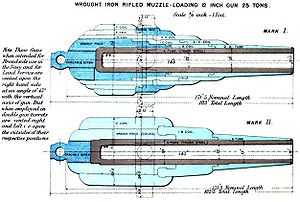RML 12 inch 25 ton gun
| Ordnance RML 12 inch 25 ton gun | |
|---|---|
|
A 12-inch (305 mm) 25-ton gun in an armoured turret aboard the ram HMS Hotspur. A shell is suspended near the muzzle ready for loading. | |
| Type |
Naval gun Coast defence gun |
| Service history | |
| Used by | Royal Navy |
| Production history | |
| Designed | 1864 - 1866 |
| Manufacturer | Royal Arsenal |
| Unit cost | £1,716[1] |
| Produced | 1866 - 187? |
| Variants | Mk I, Mk II |
| Specifications | |
| Weight |
Mk I : 23.5 long tons (23,900 kg) Mk II : 25 long tons (25,000 kg) |
| Barrel length | 145 inches (3.7 m) (bore + chamber)[2] |
|
| |
| Shell |
600 to 608.4 pounds (272.2 to 276.0 kg) (Palliser) 497 pounds (225.4 kg) (Common & Shrapnel) |
| Calibre | 12-inch (304.8 mm) |
| Muzzle velocity | 1,300 feet per second (400 m/s)[3] |
The RML 12 inch 25 ton guns were large rifled muzzle-loading guns used as primary armament on British ironclad turret battleships and coastal monitors, and also ashore for coast defence. They were the shorter and less powerful of the two 12-inch (305-mm) British RML guns, the other being the 35-ton gun.
Design

_12-inch_gun_rear_view.jpg)
Mark I
Four guns were first made in 1866 with a toughened mild steel tube surrounded by multiple wrought iron coils on the original Armstrong pattern.
Mark II
While strong, the multiple coils were considered too expensive for construction in quantity. From 1867 guns were built on the simplified and hence cheaper "Fraser" system involving fewer but larger coils similar to the 10-inch (254-mm) Mk II gun. The guns were not considered a success, with the rifling twist of 1 in 100 increasing to 1 in 50 considered insufficient for accuracy, and guns were retubed in 11-inch (279-mm) calibre when their bores wore out.[4]
Naval service
Guns were mounted on :
- HMS Captain (1869) : 4
- HMS Monarch (1868) : 4
- HMS Hotspur (1870) : 2
- HMS Glatton (1871) : 2
- HMS Belleisle (1876) : 4
- HMS Orion (1879) : 4
Ammunition
The gun's primary projectile was 600 to 608-pound (272- to 275-kilogram) "Palliser" armour-piercing shot, fired with a "Battering charge" of 85 pounds (38.5 kilograms) of "P" (gunpowder) or 67 pounds (30.4 kilograms) "R.L.G." (gunpowder) for maximum velocity and hence penetrating power. Shrapnel and Common (exploding) shells weighed 497 pounds (225.5 kilograms) and were fired with a "Full charge" of 55 pounds (25 kilograms) "P" or 50 pounds (22.7 kilograms) "R.L.G.".[5]
-

Palliser shot
See also
Surviving examples
Notes and references
- ↑ Unit cost of £1,715 13 shillings 5 pence is quoted in "The British Navy" Volume II, 1882, by Sir Thomas Brassey. Page 38
- ↑ Treatise on Construction of Service Ordnance 1877, page 292
- ↑ MV of 1,300 feet/second firing 600-pound projectile with "Battering charge" of 85 pounds "P" (gunpowder) is quoted in "Treatise on Construction of Service Ordnance 1877", page 348. MV of 1,292 feet/second firing 608 lb 6 oz projectile with "Battering charge" of 85 pounds "P2" (gunpowder) is quoted in "Text Book of Gunnery 1887" Table XVI
- ↑ Treatise on Construction of Service Ordnance 1877, pages 92-94
- ↑ Treatise on Ammunition 1877, pages 191,194, 220
Bibliography
- Treatise on Ammunition. War Office, UK, 1877
- Treatise on the construction and manufacture of ordnance in the British service. War Office, UK, 1877
- Text Book of Gunnery, 1887. LONDON : PRINTED FOR HIS MAJESTY'S STATIONERY OFFICE, BY HARRISON AND SONS, ST. MARTIN'S LANE
- Sir Thomas Brassey, The British Navy, Volume II. London: Longmans, Green and Co. 1882
External links
| Wikimedia Commons has media related to RML 12 inch 25 ton gun. |
| ||||||||||||||||||||||||||||||||||||||||||||||||||||||
_12-inch_gun.jpg)